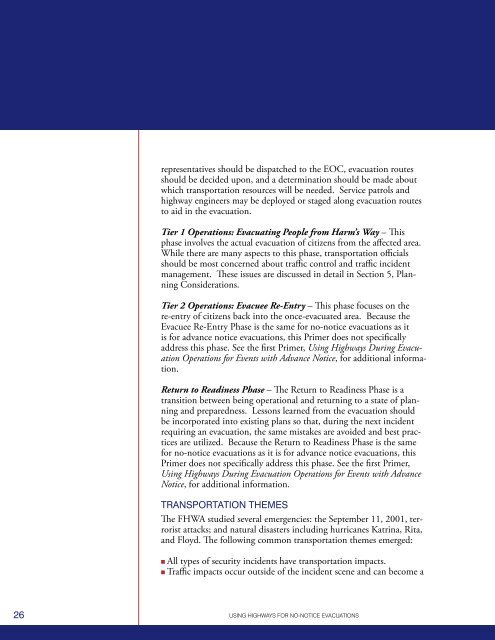using highways for no-notice evacuations - FHWA Operations - U.S. ...
using highways for no-notice evacuations - FHWA Operations - U.S. ...
using highways for no-notice evacuations - FHWA Operations - U.S. ...
You also want an ePaper? Increase the reach of your titles
YUMPU automatically turns print PDFs into web optimized ePapers that Google loves.
epresentatives should be dispatched to the EOC, evacuation routesshould be decided upon, and a determination should be made aboutwhich transportation resources will be needed. Service patrols andhighway engineers may be deployed or staged along evacuation routesto aid in the evacuation.Tier 1 <strong>Operations</strong>: Evacuating People from Harm’s Way – Thisphase involves the actual evacuation of citizens from the affected area.While there are many aspects to this phase, transportation officialsshould be most concerned about traffic control and traffic incidentmanagement. These issues are discussed in detail in Section 5, PlanningConsiderations.Tier 2 <strong>Operations</strong>: Evacuee Re-Entry – This phase focuses on there-entry of citizens back into the once-evacuated area. Because theEvacuee Re-Entry Phase is the same <strong>for</strong> <strong>no</strong>-<strong>no</strong>tice <strong>evacuations</strong> as itis <strong>for</strong> advance <strong>no</strong>tice <strong>evacuations</strong>, this Primer does <strong>no</strong>t specificallyaddress this phase. See the first Primer, Using Highways During Evacuation<strong>Operations</strong> <strong>for</strong> Events with Advance Notice, <strong>for</strong> additional in<strong>for</strong>mation.Return to Readiness Phase – The Return to Readiness Phase is atransition between being operational and returning to a state of planningand preparedness. Lessons learned from the evacuation shouldbe incorporated into existing plans so that, during the next incidentrequiring an evacuation, the same mistakes are avoided and best practicesare utilized. Because the Return to Readiness Phase is the same<strong>for</strong> <strong>no</strong>-<strong>no</strong>tice <strong>evacuations</strong> as it is <strong>for</strong> advance <strong>no</strong>tice <strong>evacuations</strong>, thisPrimer does <strong>no</strong>t specifically address this phase. See the first Primer,Using Highways During Evacuation <strong>Operations</strong> <strong>for</strong> Events with AdvanceNotice, <strong>for</strong> additional in<strong>for</strong>mation.TrANSPORTATION THEMESThe <strong>FHWA</strong> studied several emergencies: the September 11, 2001, terroristattacks; and natural disasters including hurricanes Katrina, Rita,and Floyd. The following common transportation themes emerged:n All types of security incidents have transportation impacts.n Traffic impacts occur outside of the incident scene and can become a26 USING HIGHWAYS FOR NO-NOTICE EVACUATIONS
















